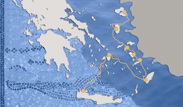The castle
The
Frankish conquest of Constantinople in 1204 was a
crucial point in Byzantine history, with major repercussions for all the
territories in the empire. It marked the beginning of the Frankish period on Naxos, leading to its emergence as the capital of the
newly created Duchy of the Aegean. Naxos Castle
was built in the early 13th century by the first Venetian ruler of
the island, Marco Sanudo II, on the site of the ancient acropolis. It is now considered
the most typical example of a fortified medieval settlement in the Cyclades.
The
irregularly shaped wall encloses an area of about 2 hectares. The original enceinte largely
followed the lie of the land, so it was not necessary to create a perimeter
moat or rampart. Of the sixteen towers that reinforced the wall, seven are
still visible. The only one to have survived in its entirety is the Glezos or Crispi Tower
near the main gate known as the Trani Porta, in the northwest of the wall,
which provided the shortest route to the port. The second major gate, also
called the Paraporti, was created in the south-west of the wall at the easiest
point of access to the castle, linking it to the hinterland.
Multiple
repairs to the walls confirm that the monument was subject to constant
modification, a fact reflected in buildings from various eras in the castle interior.
The Venetian period Catholic Cathedral of Naxos was built for the enthronement
of the Latin Archbishop in 1244, when the Diocese of Naxos seceded from Athens and declared its
independence. The church originally had three aisles, a raised central transept and a dome at the intersection; drastic alterations after 1616 ended in the
current five-aisled plan.
and a dome at the intersection; drastic alterations after 1616 ended in the
current five-aisled plan.
This period saw the construction of the now ruined
central tower, which served as the residence of the Venetian ruler, as well as
the chancellery and the ducal administrative centre, which is now the Catholic
bishop’s palace. These three buildings were laid out in the way typical of a
medieval fortified city centre. The architecturally rich appearance of the
castle was complemented by Panagia (Our Lady) Theoskepasti, the only Orthodox church,
which predates the wall; the former Commercial
School run by the
Salesians, now home to the Naxos
Archaeological Museum;
and the Ursuline convent school complex.
Bibliography (3)▼
Comments (0)▼
New Comment▼












